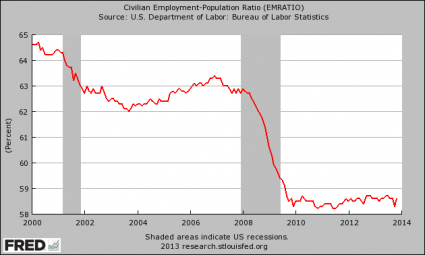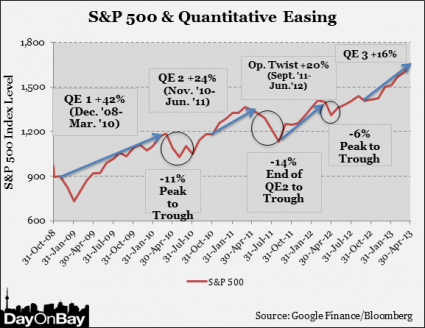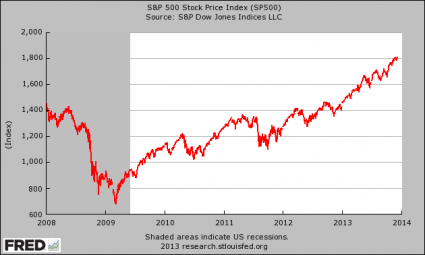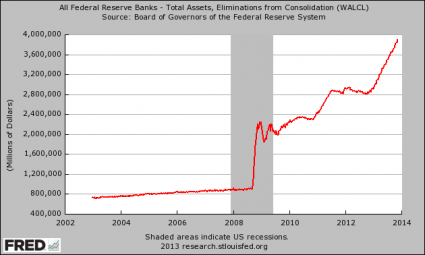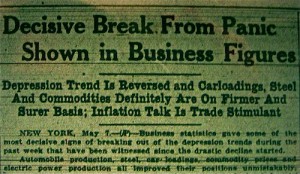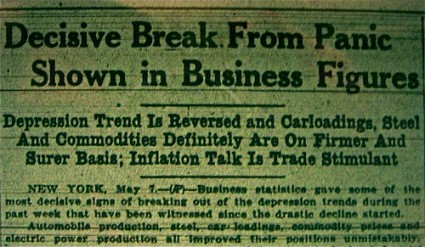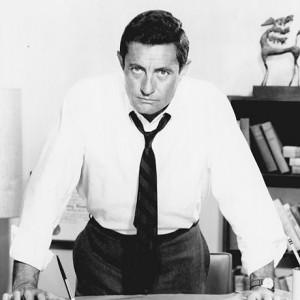 In America today, there are close to 50 million people living in poverty and there are more than 100 million people that get money from the federal government every month. As the middle class disintegrates, poverty is climbing to unprecedented levels. Even though the stock market has been setting record high after record high, the amount of anger and frustration boiling just under the surface in our nation grows with each passing day. And now extended unemployment benefits have been cut off for 1.3 million unemployed Americans, and it is being projected that a total of 5 million unemployed Americans will lose their benefits by the end of 2014. In addition, as I have written about previously, 47 million Americans recently had their food stamp benefits reduced. The conditions for a “perfect storm” are certainly being created. So how much longer will it be until we see all of this anger and frustration boil over in the streets of our major cities? Is America about to reach a breaking point?
In America today, there are close to 50 million people living in poverty and there are more than 100 million people that get money from the federal government every month. As the middle class disintegrates, poverty is climbing to unprecedented levels. Even though the stock market has been setting record high after record high, the amount of anger and frustration boiling just under the surface in our nation grows with each passing day. And now extended unemployment benefits have been cut off for 1.3 million unemployed Americans, and it is being projected that a total of 5 million unemployed Americans will lose their benefits by the end of 2014. In addition, as I have written about previously, 47 million Americans recently had their food stamp benefits reduced. The conditions for a “perfect storm” are certainly being created. So how much longer will it be until we see all of this anger and frustration boil over in the streets of our major cities? Is America about to reach a breaking point?
If you think that the title of this article is “alarmist”, you probably have not been paying attention to what has been happening over the past few weeks. For example, a 600 person brawl broke out at at movie theater in Jacksonville, Florida just the other day…
Five teenagers were arrested when a 600-person brawl broke out in a Florida movie theater’s parking lot on Christmas night.
Described by police as a “melee,” the fight occurred around 8:30 p.m. on Wednesday outside the Hollywood River City 14 movie theater in Jacksonville when a group tried to storm the theater’s doors without purchasing tickets, police said. Several had rushed an off-duty police officer working as a security guard.
The officer “administered pepper spray to disperse the group, locked the doors and called for backup, following protocol,” said Lauri-Ellen Smith, a spokeswoman for the Jacksonville Sheriff’s Office.
Soon after the pepper spray was used, “upward of 600 people moving throughout a parking lot about the size of a football field began fighting, disrupting and jumping on cars,” she said.
And a “flash mob” of “400 crazed teens” was so violent that it forced a mall in Brooklyn to shut down just a few days ago…
A wild flash mob stormed and trashed a Brooklyn mall, causing so much chaos that the shopping center was forced to close during post-Christmas sales, sources said Friday.
More than 400 crazed teens — who mistakenly thought the rapper Fabolous would perform — erupted into brawls all over Kings Plaza Shopping Center in Mill Basin on Thursday at 5 p.m., sources said.
The troublemakers looted and ransacked several stores as panicked shoppers ran for the exits and clerks scrambled to pull down metal gates.
In addition, the release of new Air Jordan sneakers caused mini-riots and brawls to break out all over the country just before Christmas.
So why is all of this happening?
Of course people will come up with all sorts of theories to explain these outbreaks of violence, but what pretty much everyone should be able to agree on is that we are seeing levels of anger and frustration rise to very dangerous levels in this country.
Right now, there are approximately 6 million Americans in the 16 to 24-year-old age group that are not in school and that are not working either. What that means is that we have an alarmingly high number of very frustrated young people that do not have anything better to do than to cause trouble.
In some of our largest cities this has become a massive problem. In fact, quite a few major U.S. cities actually have more than 100,000 “idle youth” living in them…
Just look at some of the nation’s largest cities. Chicago, Houston, Dallas, Miami, Philadelphia, New York, Los Angeles, Atlanta and Riverside, Calif., all have more than 100,000 idle youth, the Opportunity Nation report found.
But the Obama administration says that this should not be a problem. In fact, the Obama administration tells us that the unemployment rate has been steadily “declining” and that there are plenty of opportunities for everyone.
Of course that is a giant lie. Just before the last recession, about 63 percent of all working age Americans had a job. During the recession that number fell below 59 percent and it has stayed there ever since…
So the notion that we are experiencing an “employment recovery” is absolutely laughable.
But most of our politicians appear to believe this lie, and it is being used as justification to cut off extended unemployment benefits.
And the funny thing is that by cutting off these benefits, it is going to make it appear as though unemployment has gone down even more. Millions of unemployed workers that are being forced into the streets will now be counted as having “left the labor force”, and it is being projected that the unemployment rate could decline by as much as half a percentage point as a result.
What a joke.
A lot of the people that are having their benefits cut off are really hurting. For instance, consider the case of 63-year-old paralegal Laura Walker…
“Not all of us have savings and a lot of us have to take care of family because of what happened in the economy,” said Walker, of Santa Clarita, who said she has applied for at least three jobs a week and shares an apartment with her unemployed son, his wife and two children. “It’s going to put my family and me out on the streets.”
So what is she going to do?
Well, at this point she appears to be down to just one option…
“I just don’t know what to do, except pray.”
And of course the unemployed are not the only ones that have had their benefits cut. As I mentioned above, all 47 million Americans that are currently on food stamps recently had their benefits reduced. The following is an excerpt from a recent article by Mac Slavo…
Earlier this year government benefits for nutritional assistance were reduced after the expiration of emergency legislation that was enacted following the 2008 financial collapse. Nearly all of the 48 million people receiving food stamp distributions were affected. The move led to warnings from food pantries and recipients around the country who said that the $40 billion in cuts would leave many American families without the ability to put food on dinner tables across America. According to Feed America, the roughly $29 per family that would no longer appear on their EBT cards will amount to about 1.5 billion meals in 2014.
The fact that government dependence has soared to all-time highs even in the midst of this so-called “economic recovery” is just another sign that the middle class is dying. For years, middle class families have tried strategy after strategy in an attempt to survive, but now it has become apparent that the middle class is rapidly approaching a breaking point…
Rising income inequality is starting to hit home for many American households as they run short of places to reach for a few extra bucks.
As the gap between the rich and poor widened over the last three decades, families at the bottom found ways to deal with the squeeze on earnings. Housewives joined the workforce. Husbands took second jobs and labored longer hours. Homeowners tapped into the rising value of their properties to borrow money to spend.
Those strategies finally may have run their course as women’s participation in the labor force has peaked and the bursting of the house-price bubble has left many Americans underwater on their mortgages.
And even though the Obama administration and the mainstream media have tried to convince us over and over that the economy is “getting better”, most Americans are not buying it. In fact, according to a new CNN poll, 70 percent of all Americans believe that “the economy is generally in poor shape”.
As the economy continues to decline, not all Americans will respond to their desperate situations by getting violent. Many suffer quietly, hoping that things will eventually turn around for them. Unfortunately, the ranks of the suffering grow with each passing year. For example, a recent CNN article discussed the continued growth of “tent cities” all over America…
The total number of homeless people residing in tents and makeshift homes is unknown. Many of these communities are small and hidden from public view, while others claim hundreds of residents and are sprinkled through major urban areas.
Some, like those tucked under roadways, are temporary and relocate frequently. Their conditions are vile, unsanitary and fail to provide refuge from storms and winds. Then there are communities, such as Dignity Village in Portland, Oregon, that have a more sustained presence. The 13-year-old “ecovillage” set up by homeless people is hygienic and self-sufficient.
Preliminary findings by The National Law Center on Homelessness and Poverty show that tent cities have been documented in almost every state, and they’re growing.
So how do we solve these problems?
Are there any solutions that could get us out of this mess?
Of course there are. But don’t hold your breath waiting for any of them to be adopted. In fact, the American people continue to express great support for the very people that got us into this mess in the first place. For example, according to a Gallup survey that was just released, Barack Obama is the most admired man in America by a very wide margin and Hillary Clinton is the most admired woman in America by a very wide margin.
And the mainstream media will continue to tell all of us that “leaders” like Obama, Clinton, Reid, Boehner, McConnell and Pelosi can be trusted to get us out of this mess.
If you believe that, there is a bridge that I would like to sell you.
The American people need to stop having blind faith in the relentless propaganda that is being spewed at them through their televisions screens. The pretty faces that you see “reporting the news” do not care about you and they are not watching out for your best interests. The corporate-controlled news is highly scripted and it is pretty much the same whatever channel you turn to. If you have any doubt that “the news” is scripted, just check out this video…
